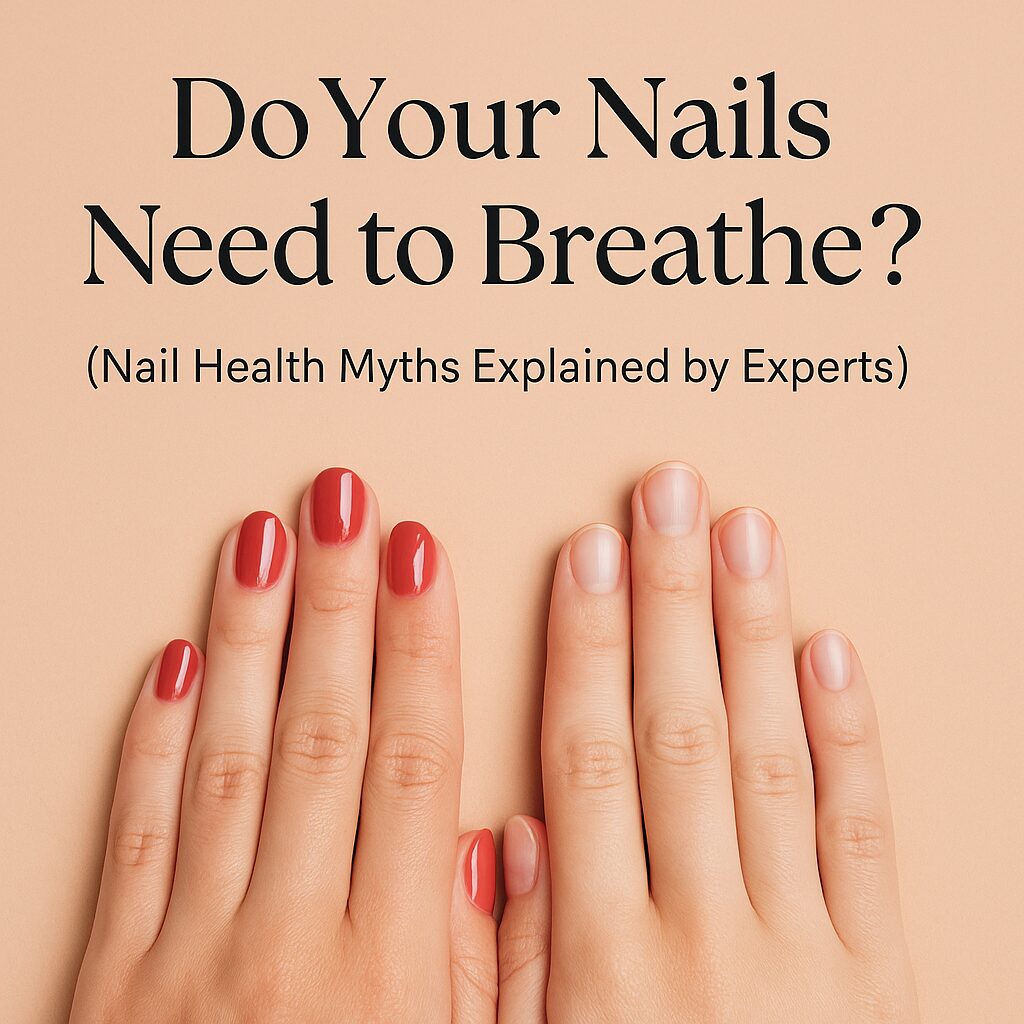
Contrary to popular belief, nails don’t actually “breathe” or require oxygen in the way skin does. Nails are made of dead keratin cells and don’t have living tissue, so they cannot absorb oxygen or require air circulation to stay healthy.
However, this doesn’t mean you should wear polish 24/7—nails do benefit from breaks for other important reasons.
Continuous polish or gel applications can trap moisture and prevent natural oils from nourishing the nail bed, leading to dryness and brittleness.
Taking breaks allows the nail bed beneath to stay healthy and prevents damage from constant chemical exposure and UV light from gel curing.
The Myth: “Do Your Nails Need to Breathe”
The idea that nails need to “breathe” comes from good intentions. Many people notice that after wearing polish or gels for weeks, their nails look dull, dry, or brittle. Naturally, they assume it’s because the nails were “suffocating” under all that product.
However, nails don’t breathe — because they can’t.
The visible part of your nail (called the nail plate) is made entirely of dead keratin cells. Oxygen and nutrients that support nail growth come from your bloodstream, not from air exposure. That’s why applying polish or gel doesn’t block “airflow” or harm your nails in that way.
If your nails look or feel unhealthy after continuous manicures, it’s not due to lack of oxygen — it’s because of dehydration, over-filing, or exposure to harsh chemicals during application and removal.
What Nails Are Actually Made Of
To understand why nails don’t need air, it helps to know a little about nail anatomy.
Your nails are made up of three key parts:
- Nail Plate: The hard, visible surface — what you see and paint.
- Nail Bed: The skin underneath the nail plate, containing nerves and blood vessels.
- Matrix: The root of the nail where new cells are formed.
Source: Healthline.com
The nail plate itself is not alive — meaning it doesn’t “breathe,” absorb oxygen, or require air contact. Instead, oxygen and nutrients come from your bloodstream and are delivered through the matrix beneath the skin.
So no matter how long your nails are polished, your natural growth continues unaffected.
What Really Happens When You Wear Nail Polish or Gel
If polish and gel don’t stop your nails from breathing, why do some people notice damage or dryness after using them for long periods?
The answer lies in the process, not the polish itself.
When you prepare nails for gel, they’re often buffed to create a smooth surface. Over time, this can thin the nail plate. Then, during removal, soaking in acetone or scraping away cured gel can strip your nails of their natural oils, leading to dryness and peeling.
The result can look like “suffocated nails” — but it’s actually dehydration and surface damage.
The key isn’t to avoid polish altogether — it’s to balance your routine with proper care and recovery periods.
Why Nail Breaks Still Matter (Even If Nails Don’t Breathe)
Even though nails don’t need oxygen, short breaks between manicures are still incredibly beneficial — just for different reasons.
Regular polish and gel use can leave nails dry and fragile, and acetone exposure during removal can strip away essential lipids that keep the nail flexible. By taking short breaks, you allow your nails to rehydrate and rebuild their natural balance.
Most nail experts recommend a 1–2 week break every 2–3 manicures.
That’s enough time to restore moisture, apply strengthening treatments, and give your nails a reset before your next polish session.
Think of it as maintenance — not deprivation.
What Your Nails Actually Need to Stay Healthy
Your nails may not need air, but they do need care — both from the inside and outside.
Internal Nail Care
Healthy nails start from within.
- Hydration: Drink enough water daily to prevent brittleness and dryness.
- Nutrition: Include foods rich in protein, biotin, and zinc — like eggs, salmon, and leafy greens.
- Consistency: Nail strength reflects your overall health, so consistent nourishment matters.
External Nail Care
Nail strength also depends on how you treat them externally.
- Use cuticle oil daily to keep the nail plate flexible.
- Apply a strengthening base coat between manicures.
- File gently — avoid aggressive buffing or shaping.
- Always wear gloves when cleaning or doing dishes to prevent exposure to harsh chemicals.
Nails stay healthiest when they’re hydrated, protected, and not over-processed. Air has nothing to do with it — but care has everything to do with it.
Source: webmd.com
What to Do During a Nail Break
If you’ve decided to take a polish-free week or two, focus on restoring your nails’ natural balance.
Here’s what a good “nail break” looks like:
- Moisturize Daily: Massage cuticle oil or hand cream into nails at least twice a day.
- Apply a Strengthener: Use a keratin or calcium-based formula for extra reinforcement.
- Avoid Soaking: Too much water exposure can make nails soft and weak.
- Keep Them Short: Trim nails to reduce breakage while they recover.
- Stay Bare Occasionally: Going polish-free for a few days allows natural oils to rehydrate the surface.
These small steps help restore smoothness and flexibility so your next manicure lasts longer and looks better.
Common Nail Problems Mistaken for “Suffocation”
Many nail concerns that people attribute to “lack of air” are actually caused by other factors.
| Nail Issue | Real Cause | Solution |
|---|---|---|
| White spots | Nail dehydration or minor trauma | Hydrate with oil and avoid over-buffing |
| Peeling or flaking | Over-filing or harsh polish removal | Use strengthening treatments between sets |
| Soft or thin nails | Continuous gel wear without rest | Take a 2–3 week break and apply repair formulas |
| Yellow nails | Long-term polish wear without base coat | Use a stain-blocking base and gentle remover |
None of these issues have anything to do with oxygen — they’re all related to moisture, technique, or product use.
What Science Says: Nails Don’t Need Air — They Need Balance
Dermatologists and nail educators agree: nails don’t breathe, but they do need balance — the right mix of protection, hydration, and recovery.
A strong nail care routine includes:
- Allowing periodic polish-free days.
- Using cuticle oil and nourishing creams regularly.
- Avoiding harsh acetone removers whenever possible.
- Protecting nails with gloves during cleaning tasks.
- Using quality base coats before polish or gel application.
When your nails are consistently moisturized and not over-processed, they’ll stay smooth, strong, and glossy — no “breathing” required.
FAQs
Q1: Do nails need to breathe between manicures?
No. Nails are made of keratin and don’t absorb oxygen. They do, however, benefit from breaks to restore natural moisture.
Q2: How long should I take a break from polish or gel?
A 1–2 week break after every 2–3 manicures helps your nails recover.
Q3: Why do my nails look dry after gels?
It’s due to dehydration from acetone or over-filing during removal, not lack of air.
Q4: Can polish block nutrients from reaching my nails?
No. Nutrients come from your bloodstream, not the air around your nails.
Q5: What’s the best way to keep nails healthy?
Hydrate them daily, use strengthening treatments, and follow a balanced manicure schedule.
